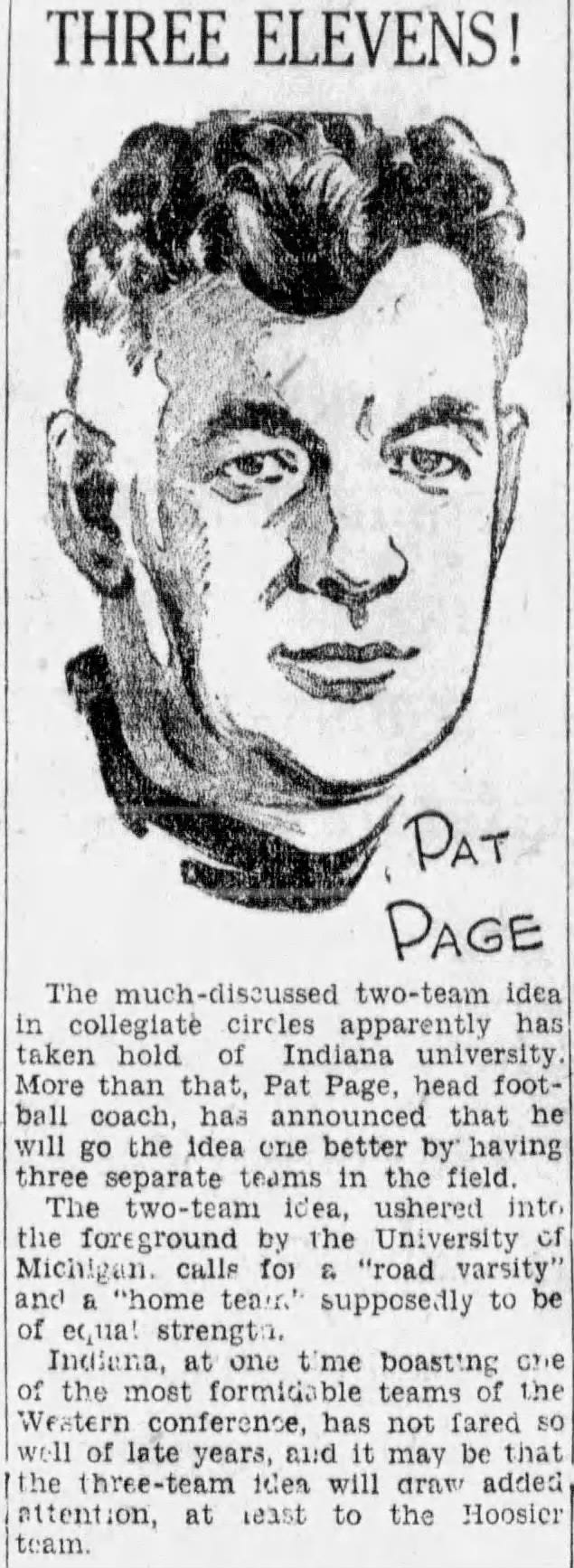Today's Tidbit... Two-Teaming College Football
As the U.S. military processed several million enlistees and draftees into the armed forces in 1917 and 1918, it became clear that American men were not in great shape. They weren't even in good shape.
The poor condition of the incoming servicemen impacted the training in the military camps but also had an effect post-war when efforts began to promote physical health in the general populace. This affected American universities in two ways. One was adding physical education requirements for most students, and the second was to initiate intramural athletic programs. Before the war, schools commonly had interclass competitions, but the intramural programs aimed for much wider participation.
A related line of thinking impacted college football when Michigan President C. C. Little made a 1926 proposal for schools to allow more students to participate in varsity competitions. Many state universities had become large enough that their student bodies included excellent athletes who could not make the varsity team but could play on a second team. The proposal went nowhere in 1926 but gained the approval of Big Ten athletic directors and faculty members in 1927. The ultimate vision was for each Big Ten school to field two teams, with the first and second teams playing home and away games each weekend.
Since Michigan's 1928 schedule was already set, Michigan planned for the first team to play six home and two away games; a second team would play six away games, largely against smaller colleges. Still, Fielding Yost suggested that the two teams might balance their talent in future years. Basketball, baseball, and track and field were also expected to follow the two-team format.
Following the approval of the two-team format in late 1927, only Michigan and Iowa committed to moving ahead in 1928.
Chicago ruled it out due to its limited enrollment, while Illinois and Wisconsin were undecided. Minnesota opted out for 1928 but would consider it in the future.
In late July and early August, newspapers still touted the two-team plan. Indiana initially planned three teams but then cut it back to two, hosting a doubleheader in the season opener, beating Wabash 14-0 and Indiana State 39-0.
Michigan made some noise about sending a second team to play Mt. Union on the first weekend of the season, but they had bigger problems. Athletic director Fielding Yost interfered with the football coaching, contributing to an 0-4 start, including a 17-7 home loss to Ohio Wesleyan. Surprisingly, Chicago opted to play a doubleheader on the season's opening day when their varsity lost to South Carolina 6-0, and their reserves lost 12-0 to Ripon 12-0.

As far as I can tell, none of the Big Ten teams ever made good on the initial plans, though a number held doubleheader games on opening weekend from 1929 to the mid-1930s, a topic covered in a 2020 article, The Good Old Days of Football Doubleheaders. When I wrote that article, I was unaware of the broader two-team plan that never came to fruition, and only the series of doubleheader games ever came from this effort. Michigan, for example, played doubleheaders in 1929, 1930, and 1931 and counts all six victories in their win totals. Other schools, like Chicago, count only the games in which their top team appeared.
Of course, college football went in a direction different than C. C. Little recommended. The two-team model lasted only a few years and the only for one weekend per year. Schools often field junior varsity, reserve, and freshmen teams that played outside competition, but those games were positioned as nothing more than opportunities for nonstarters to have the opportunity to hit someone in a different color uniform.
What might have been had it worked out differently? Michigan might have played in one national championship game tonight and another one tomorrow.
Football Archaeology is reader-supported. Click here to buy one of my books or otherwise support the site.




This reminds me of the 1896 West Virginia team that fielded two teams on Nov. 26.